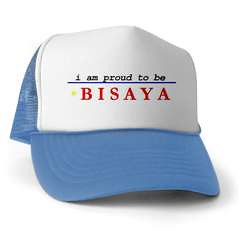That is how we mock or label people, situations and just about anything that is below par or that is less than the global standards.
Like when someone wears green pants with pink top, its bisdak in bloom. The poor fashion shocker is bisdak! It is also so bisdak to listen to Sandara’s “In or Out”, or for anyone to memorize any of April Boy’s jukebox hits. You are bisdak if you can’t find your way around Glorietta, but are a good shopper in Gaisano. So bisdak when you don’t know how to use any high-tech gadget. And you are very much a bisdak when you are hooked to an afternoon soup opera.

Bisdak has become synonymous with baranganic, the old bakya or baduy tag, Manilans’ jologs and other Filipino slang, that are use to refer to something cheap or anything is “taga- boondocks”.
Using the term this way actually puts down, and insults, our very own sensibilities as Visayans. Why not say instead talog for talagang Tagalog to mean baduy? Then we protect our own regional identity. But the way not to degrade our own senses is simply to stop using bisdak in this context. (Saying talog will only hurt our kababayans in Luzon. Let’s just forgive them for their Luzon-centric tendencies.)
Bisaya is our color; an identity that has long been written in our history as people. It runs deep into our culture. Most important of all, it is our language.
I hate it when people think that those who are more comfortable expressing themselves in Bisaya are less intelligent than those who are fluent in English. In school, if you can mouth English fluently, you can be elected class president hands down. even if it is without sense. Speaking English has become part of a status symbol.
To speak fluently in Bisaya , however, is like committing a crime. As a result of this kind of attitude, many words in Bisaya have died in the tongue of the new generations of Visayans.
Bisaya as a language is rich and beautiful. To a large extent, it is even more powerful than the English language. Consider the verb “to carry” in English: I will carry it on my head, carry with my hand and carry it on my back. It’s the same word for all - so boring and redundant.
But with Bisaya, there is a word to use for every manner of carrying. Lukdô when you will carry something on your head, bitbit when you carry using your hand, baba when on you carry it on your back, pas-an when you carry it on your shoulder, etc.
How about the overused word “love”? I love my darling, I love my dog, I love to travel, I’d love to kill you, I love to eat.
But gugma in Bisaya sounds special and truly endearing. You can’t use it just for anything. It’s a big blunder if you were to say “Nahigugma ko sa pagkaon sa Cafeteria.” The Visayan gugma is “love for special someone.” It can not be reduced to the level of expressing love for foodstuff or a dog.
Bisaya is indeed rich, it is a beautiful language to express real emotions. Even anger sounds stronger when expressed in Bisaya. Yati na!Pesteng yawa!
It was with great joy when I witnessed the only Visayan song among the entries – Ernest Hope Tinambacan’s Mata sa Mata – was adjudged the grand prize winner in the 2005 Valentine Song Writing Contest at Silliman University. The contest was dominated with songs written in English. There were two songs in Tagalog but the beautiful flow of the lyrics in Bisaya and the contemporary arrangement by Gina Raakin gave justice to its intensity. Feel Earnest’s yearnings:
Sa akong mga mata imong hikaplagan
And imong gipangandoy nga
Gugmang wa’y paglubad
Sa akong mga mata imong Makita
Ang imong gipangandoy nga kamatuoran
Ang gugma ko alang kanimo
Sa imong mga mata akong nahikaplagan
Nga may pagbati ka usab sulod sa imong dughan
Sa imong mga mata akong nakita
Nagduha-duha ka ning akong gugma
O, ‘day paminawa
Ang gugma ko alang kanimo
Hangtud sa kahangturan ug walay katapusan
Sa kalipay ug sa kalisdanan
Hangtud sa kahangturan ug walay katapusan
Ikaw akong paga-unongan
Kay ikaw gihigugma ko…
It is simply amazing to know that such an expression was made by a very young composer, a Mass Communication student. Mata sa Mata gives hope for the language to be brought back to the mainstream. In its humble way, Mata sa Mata actually achieved a similar glory as Cesar Montano’s Panaghoy sa Suba, a Bisaya film that successfully provided the Filipino an experience of the beauty of our very own language and color.
Be proud you are a BISDAK!